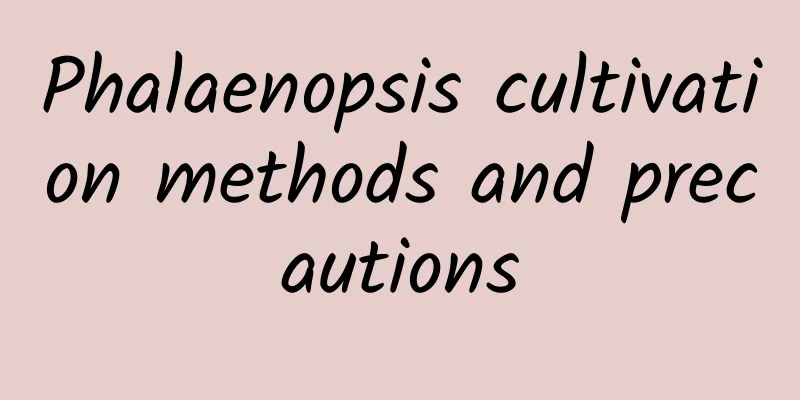Phalaenopsis cultivation methods and precautions

|
Phalaenopsis is named after the beautiful orchid that looks like a butterfly and has the reputation of "Queen of Orchids". It is a very pleasing thing to grow a Phalaenopsis at home. Let me introduce to you the cultivation methods and precautions of Phalaenopsis. Phalaenopsis cultivation methods and precautions Phalaenopsis cultivation method: 1. Soil: The potting soil of Phalaenopsis should be loose and breathable, and the culture medium can be mainly moss and aquatic plants. 2. Temperature. Phalaenopsis prefers a high temperature and high humidity environment, and the suitable temperature is between 16 and 30 degrees. When keeping warm in winter, be careful not to place it too close to the heater. 3. Humidity. Phalaenopsis is suitable for cultivation in an environment with high ventilation and humidity, so water it frequently during the vigorous growth period of new roots, once in the morning and once in the afternoon. Be careful not to water it when a cold wave hits, and resume watering afterwards. 4. Light. Phalaenopsis prefers shade and should be avoided from direct sunlight, but it also needs partial light. Before and after the flowering period, appropriate light can promote the flowering of Phalaenopsis. Generally, it can be placed indoors with scattered light. 5. Fertilization. Phalaenopsis needs to be fertilized throughout the year. Thin organic fertilizers can be applied in spring and summer, and thin phosphorus fertilizers can be applied in autumn and winter. Nitrogen and potassium fertilizers can be applied in summer when leaves grow. Phalaenopsis Notes: 1. Watering too frequently. Watering every day can cause serious root rot. 2. Temperatures are too low. Nighttime temperatures in your home may be too low for your plants to thrive. 3. Excessive fertilization. Fertilizer should be applied thinly and in small amounts and multiple times. Too much fertilizer will have the opposite effect. 4. Disease prevention and control: If there is a disease, it should be isolated in time and controlled with living things. |
<<: How to keep flowers fresh? Tips on how to keep flowers fresh
Recommend
Characteristics and yield performance of Xialu No. 3 loofah
I don’t know if you have heard of Xialv No. 3 loo...
Nutritional value of spring bamboo shoots
Spring bamboo shoots are delicious and rich in nu...
Nutritional value and benefits of coconut
Coconut is the most common fruit in the southern ...
Mushroom Porridge
I believe everyone is familiar with mushroom porr...
How to quickly eliminate mango allergy? The simplest way to treat mango allergy
Mango is sweet, tender and nutritious. It is a de...
Nutritional value and efficacy of Tremella
Tremella is a rare fungus with high nutritional v...
The benefits of eating papaya How to eat papaya nutritionally
Papaya is a popular fruit. It can help with beaut...
How to make Mian Yin Chen porridge
How many of you know how to make Mian Yin Chen Co...
What are shallots? How to grow shallots
Although shallots are very common ingredients, th...
The efficacy, function and edible method of yew
In the eyes of many people, yew is just a beautif...
What is the International Air Transport Association? IATA reviews and website information
What is the website of IATA? The International Air...
How is CBIZ Accounting Firm? CBIZ Accounting Firm Reviews and Website Information
What is the website of CBIZ Accounting Firm? CBIZ ...
How is My Monthly Cycles? My Monthly Cycles Review and Website Information
What is My Monthly Cycles? My Monthly Cycles is a ...
How long is the shelf life of Lafite red wine?
Lafite red wine is a category produced by the ver...
How to grow Kalanchoe? Cultivation methods and precautions for Kalanchoe
Kalanchoe, also known as longevity flower, belong...









